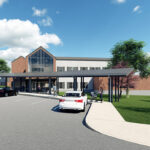When Capital Region Water formed in 2013, it inherited a water and wastewater system that was reeling from years of neglect and suffering under a massive backlog of deferred maintenance needs. Now, with the municipal authority marking its 10th anniversary this month, the city’s infrastructure is on the mend.
Over the last decade, Capital Region Water has invested more than $200 million in capital projects to restore failing infrastructure, improve the health of local waterways, and beautify neighborhoods through community greening.
And that is only the beginning. Over the next 10 years, more than $350 million will be invested to address localized flooding and fix aged and undersized infrastructure that long ago exceeded its useful life.
No one denies the challenges of maintaining and upgrading a water and wastewater system that is more than a century old in some places. Nearly 40 percent of Harrisburg’s sewer and stormwater (rainwater) infrastructure needs to be repaired or replaced.
But these improvements are essential to our quality of life and economic growth. They also go a long way in ensuring we meet our environmental obligations.
Recently, after months of negotiation and public comment, the U.S. Department of Justice approved a modification to the 2015 Partial Consent Decree among Capital Region Water, the city of Harrisburg, the U.S. Environmental Protection Agency, and Pennsylvania Department of Environmental Protection. This historic agreement defines the work we must do to continue improvements and ensure regulatory compliance.
More certainly needs to be done. But that doesn’t mean we should ignore some of the good work and significant investments that have been made over the years.
In 2016, Capital Region Water completed a $50 million biological nutrient removal (BNR) upgrade to our Advanced Wastewater Treatment Facility. We demonstrated that the facility, which employs the most cutting-edge treatment processes in the region, can reduce total nitrogen in the outflowing water to better protect the Susquehanna River and downstream in the Chesapeake Bay.
We continue to further improve the facility as evidenced by an additional $15 million investment in screening and anaerobic digester rehabilitation projects undertaken since the BNR upgrade. Additional improvements to the energy recovery systems are planned over the next few years that will significantly increase the revenue generated from this facility.
Since 2014, Capital Region Water has repaired more than 100 sinkholes created by sewer pipe failures. Fixing old, cracked pipes reduces leakage that leaches into waterways. Our team also has cleaned and inspected all 4,000-plus storm inlets to collect runoff and prevent localized flooding. Many inlets had dirt that allowed weeds and even small trees to take root preventing proper rainwater drainage.
Anyone who drives along Front Street has witnessed firsthand the investments being made in the city. Capital Region Water upgraded the Front Street Pump Station and work is wrapping up on the multi-phased Front Street Interceptor Rehabilitation Project.
In just the last few years, Capital Region Water has secured more than $141 million in low-interest PENNVEST loans from the state to complete many of the aforementioned projects, easing the burden on ratepayers.
Being able to obtain state and federal grants, low-rate loans, revolving loan funds at sub-market rates, and favored bond issues has been a hallmark of Capital Region Water’s independent five-member board, which despite being all volunteer has the relevant professional expertise to manage complex decisions and provide leadership to the 140-strong professional staff that manages daily operations.
That much can be seen in the financial turnaround of the system. When CRW assumed functions from The Harrisburg Authority, the water and sewer system essentially had junk bond status. Today, S&P Global has affirmed Capital Region Water’s A+ water and sewer bond ratings. Financial markets like predictability and stability.
Harrisburg’s water routinely ranks among the best-tasting water in the state, thanks to protections in place at the source at DeHart Dam, and we want to keep it that way. Safety improvements to the DeHart Dam are planned for 2024 and continued investments and improvements are being made to the water systems that supply that pristine water to our customers.
Managing stormwater runoff remains a priority. Capital Region Water’s stormwater fee generates about $5 million annually in dedicated funds to transform vacant lots into green spaces, improve parks, install raingardens and other stormwater infiltrating features, and manage stormwater with street-level planters that also calm traffic.
Looking back, residents should be proud of the work that has been accomplished over the last 10 years. It’s an impressive track record that should make us all realize that over the next 10 years, there isn’t much we can’t do when we do it together.
Charlotte Katzenmoyer is CEO of Capital Region Water. For more information on Capital Region Water, visit their website.
If you like what we do, please support our work. Become a Friend of TheBurg!









